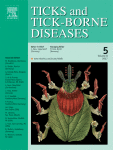Ver ítem
- xmlui.general.dspace_homeCentros Regionales y EEAsCentro Regional Santa FeEEA RafaelaArtículos científicosxmlui.ArtifactBrowser.ItemViewer.trail
- Inicio
- Centros Regionales y EEAs
- Centro Regional Santa Fe
- EEA Rafaela
- Artículos científicos
- Ver ítem
Ticks (Acari: Ixodidae) on wild birds in north-central Argentina
Resumen
Ixodid ticks were collected from wild birds in five ecoregions in north-central Argentina, namely: Selva de las Yungas, Esteros del Iberá, Delta e Islas del Paraná, Selva Paranaense and Chaco Seco. A total of 2199 birds belonging to 139 species, 106 genera, 31 families and 11 orders were captured, but ticks were collected only from 121 birds (prevalence = 5.5%) belonging to 39 species (28.1%) and three Orders: Tinamiformes (Tinamidae) and Falconiformes
[ver mas...]
Ixodid ticks were collected from wild birds in five ecoregions in north-central Argentina, namely: Selva de las Yungas, Esteros del Iberá, Delta e Islas del Paraná, Selva Paranaense and Chaco Seco. A total of 2199 birds belonging to 139 species, 106 genera, 31 families and 11 orders were captured, but ticks were collected only from 121 birds (prevalence = 5.5%) belonging to 39 species (28.1%) and three Orders: Tinamiformes (Tinamidae) and Falconiformes (Falconidae) in Selva de las Yungas and Passeriformes (Conopophagidae, Corvidae, Emberizidae, Furnariidae, Icteridae, Parulidae, Thamnophilidae, Thraupidae, Troglodytidae, Turdidae) for all ecoregions. The following tick species were found: Haemaphysalis juxtakochi, Haemaphysalis leporispalustris, Ixodes pararicinus plus Amblyomma sp. and Haemaphysalis sp. in Selva de las Yungas; Amblyomma triste and Ixodes auritulus in Delta e Islas del Paraná; Amblyomma dubitatum, A. triste and Amblyomma sp. in Esteros del Iberá; Amblyomma ovale and Amblyomma sp. in Selva Paranaense, and Amblyomma tigrinum in Chaco Seco. Amblyomma dubitatum was found for the first time on Passeriformes, while the records of A. ovale on avian hosts are the first for Argentina. Birds are also new hosts for I. pararicinus females. Besides 2 larvae and 1 nymph, and 1 larvae found on Tinamidae (Tinamiformes) and Falconidae (Falconiformes), respectively, all other ticks (691 larvae, 74 nymphs and 2 females) were found on Passeriformes with a relevant contribution of the family Turdidae. Birds are important hosts for I. pararicinus as shown by a prevalence of 45% while all others prevalence were below 15%. All the species of Amblyomma and Haemaphysalis found on birds in Argentina have been also detected on humans and are proven or potential vectors for human diseases. Therefore, their avian hosts are probable reservoirs of human pathogens in Argentina.
[Cerrar]

Autor
Flores, Fernando Sebastián;
Nava, Santiago;
Batallán, Pedro Gonzalo;
Tauro, Laura Beatriz;
Contigiani de Minio, Marta Silvia;
Diaz, Luis Adrian;
Guglielmone, Alberto;
Fuente
Ticks and Tick-borne Diseases 5 (6) : 715-721 (October 2014)
Fecha
2014-10
ISSN
1877-959X
1877-9603
1877-9603
Formato
pdf
Tipo de documento
artículo
Palabras Claves
Derechos de acceso
Restringido
 Excepto donde se diga explicitamente, este item se publica bajo la siguiente descripción: Creative Commons Attribution-NonCommercial-ShareAlike 2.5 Unported (CC BY-NC-SA 2.5)
Excepto donde se diga explicitamente, este item se publica bajo la siguiente descripción: Creative Commons Attribution-NonCommercial-ShareAlike 2.5 Unported (CC BY-NC-SA 2.5)

